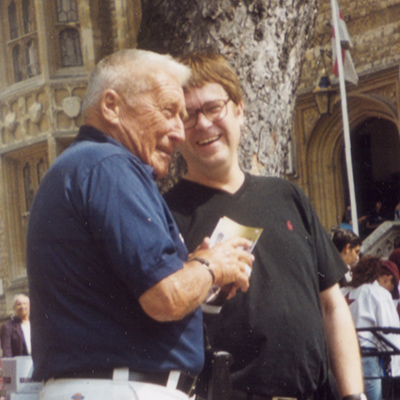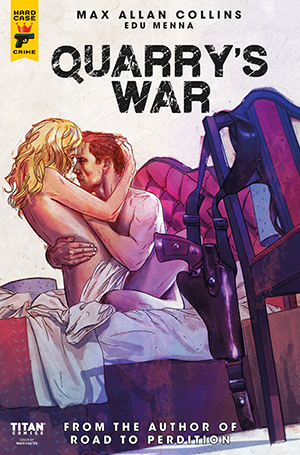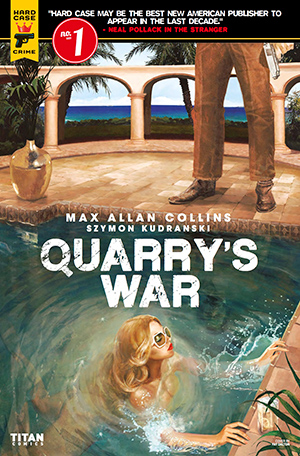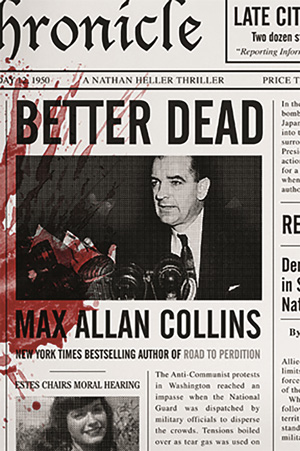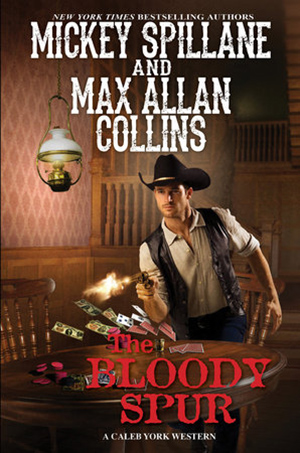
Below is an excerpt from a review of The Bloody Spur from the Western Writers of America Roundup Magazine. It’s what you’d call a mixed review, on the patronizing side, and is mostly a plot summary, which I’ve skipped. But it raises some issues I’ve been wanting to talk about.
Let me get the stereotypical charge out of the way first. Yes, the characters established in Mickey’s 1950s screenplay are stereotypical – the stranger in town who becomes sheriff, a beautiful dance hall girl, a blind rancher, a lovely tomboy, and a cantankerous coot who becomes a deputy. There’s also a local doctor. What Mickey did, and what I have continued to try to do, is make these types specific and sometimes surprising in their characterizations, and to bring a gritty, even shocking amount of Spillane-style violence to the party as well as a mystery/crime element.
I don’t mean to respond to the reviewer, just to make clear where Mickey and I are coming from.
What I want to discuss is the charge that I do too much description of setting and clothing. I have always done a good deal of that, but it’s only in recent years that the occasional reviewer (particularly the Amazon variety) has bitched about it. The same is true of the sexual element, but that doesn’t apply too much to the Caleb York novels, so I’ll save that for a future discussion.
From my point of view, too many authors send their characters running around in books stark naked, and I don’t mean in sex scenes. I view clothing as a tool of characterization. The clothing a character wears tells us who this person is, and how these characters perceive themselves, and wish to be perceived.
Setting is the same. A description of a house, interior or exterior, tells us who lives there – a bedroom, particularly, is revealing of character.
Any reader who thinks I can on too much about clothing or setting is free to skip or scan. No harm, no foul.
In an historical novel – which westerns like the Caleb York books are by definition – setting is particularly important. It is also a big part of my 20th Century-set mysteries. If I take Nate Heller to a Hooverville or a strip club, you can bet I’ll give you chapter and verse about those settings. If Heller – in a 1960s-era story, when he’s become prosperous – is something of a clothes horse, that speaks of character, of who is and what he’s become. He’s rather shallow in that regard, frankly – part of his characterization.
In a Caleb York story, if I take my hero into an apothecary or a general store, you can bet I will describe the damn thing, and in some detail. York isn’t walking into a Walgreen’s or a Safeway, after all. Part of this is taking what is a mythic western – having to do with movies and ‘50s/’60s TV, more than the reality of the west – and giving it some verisimilitude. By keeping the underpinnings real, making the setting authentic, I can get away with the melodrama.
And what I do is melodrama. Nobody uses that word anymore, at least not correctly. But much of what I have done as a writer for over forty years is present a realistic surface on which to present my somewhat over-the-top stories.
Again, feel free to skim or skip passages that bore you. Elmore Leonard, great writer that he was, pretty much left you on your own. What he did worked for him (but his “rules” of writing are worthwhile only if you want to be Elmore Leonard when you grow up, and we already have one of those).
I am well aware that I am involved in a collaborative process with the reader. It amuses me when two readers argue over whether a book is good or not, as if they shared the same experience. Obviously they didn’t. Sometimes the play or movie mounted in a reader’s mind is a big-budget, beautifully cast affair; other readers are capable only of amateur night productions.
Leonard and others may wish to cede their stories to the whims and abilities of their readers. I know to some extent that is inevitable – because no two readers will have the same experience reading fiction. But I believe in controlling the narrative to the fullest extent that I can. I consider a chief responsibility of my job is doing my job – to do the work for you, where setting and clothing are concerned and much more.
I understand and accept that I’m blessed and sometimes burdened with readers who are my inevitable collaborators. But I want them to come as close to experiencing the movie I saw in my head, and put down on paper for them, as I possibly can.
This past Saturday, Crusin’ played the first gig of the season (defined as: not winter, though we were somewhat double-crossed by April sleet and snow). We performed for the Wilton, Iowa, High School Alumni banquet, a very well-attended event that had been going since five p.m. when we went on stage around nine-thirty. We held a good share of the audience for two sets (we took no break) and debuted a lot of new material…well, old material, although a new original was included.

L to R: M.A.C., Joe McClean, Steve Kundel, Bill Anson and Brian Van Winkle.
It went well, and our old friend Joe McClean, a Wilton area boy, joined us on several numbers. Joe was the heart and soul of the great Midwestern band the XL’s, who are also in the Iowa Rock ‘n’ Roll Hall of Fame.
Our new guitar player, Bill Anson, is doing a fine job, as are longtime drummer Steve Kundel and our bassist Brian Van Winkle, the “new guy” who has been with us seven years.
It felt great playing again. Loading afterward, not so much. And two days later I still am in anybody-get-the-name-of-that-truck mode.

M.A.C., Joe McClean.
My Scarface and the Untouchable co-author, A. Brad Schwartz, has written an op-ed piece for the Washington Post that has just appeared. Though I didn’t co-write it, I did some friendly editing and the piece beautifully discusses the somewhat facile comparisons being made of Trump as Capone and Comey/Mueller as Eliot Ness.
Wild Dog is back on Arrow this year. I haven’t watched the previous year yet.
Here’s a great review by Ron Fortier of the complete version of the Road to Perdition novel published by Brash Books.
Here’s where you can get signed copies of my books, including Killing Town and The Last Stand.
Road to Perdition the film is number three on this list of the best twelve Jude Law movies.
Finally, thanks to everyone who responded to the book giveaway posted last week. The books went quickly, and my apologies to those of you who missed out. Another will follow before too very long!
M.A.C.
